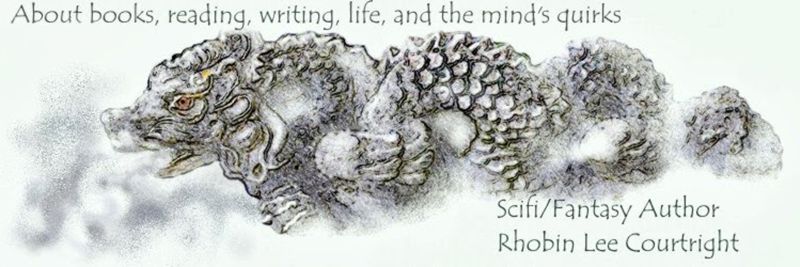In fantasy and scifi stories, wizards and aliens who seemed all-powerful were de rigueur for a long time. While these types of characters are scary, there is a problem. No character, either villain or hero, can be all-powerful. If characters are truly all-powerful, it means nothing and no one can overcome them, and this power then preordains the ending; therefore, each character has to have a weakness or fatal flaw. Even in 2001: A Space Odyssey, whose time has come and gone, HAL, the seemingly omniscient computer, had fatal flaws including paranoia.
Lately, villains have become genius ne’er-do-wells, serial killers whose evil it takes a whole team to overcome. This is another form of the all-powerful character: the one seemingly too smart to get caught. Some of these character’s perversions scare me silly, but is this type of character realistic or just a fad that comes and goes? Seriously, how many genius murders have been arrested? If we had actually developed the brain-implanted computer, it might be reasonable, but that hasn’t happened yet. Where they lose me is why would there be so many evil geniuses and so few good? It doesn’t make sense. Usually, such intelligence makes the person more perceptive, not less human.
Still, what I learned from this is that in a powerful story, the heroic character must find the villain’s flaw and play on this weakness while overcoming his or her own defects. This also seems to prove true in all other genres of fiction.
Despite fiction trends, the villains I find most scary and horrifying are those who seem a direct threat to me personally from the horror stories I hear every night on the news. These are the unrelenting variety of normal and not-so-normal humans: rage enveloped individuals; those who carry out unreasonable vendettas, or have antithetical beliefs or misunderstandings with those around them; those who have psychological problems, and those who do something stupid or illegal and try to hide it without worrying about consequences. I read recently where sociopaths make up 1 to 3% of our population, not that all sociopaths are bent to evil endeavors, but the the statistic gives the writer a believable base to develop their malevolent character, and the reader a reasonable excuse to suspend their disbelief and fall into the story. These include manipulating, mesmerizing cult, religious, or governmental leaders, enemies disguised as friends, scoundrels who only care about their own advancement, suicidal egos willing to take anyone and everyone in their personal Armageddon, and profiteers who gain from others’ suffering – the world is full of them. Since everyone has heard stories about such miscreants and knows this evil exists, characters based on this reality can easily instill terror, especially when dressed in the persona of neighbor, friend, or family.
For other views on villains, visit the round-robin topic starting with author Anne Stenhouse. Be sure to visit all those listed!
A.J. Maguire
Marci Baun
Diane Bator
Fiona McGier
Ginger Simpson
Geeta Kakade
Connie Vines
Beverley Bateman
Lately, villains have become genius ne’er-do-wells, serial killers whose evil it takes a whole team to overcome. This is another form of the all-powerful character: the one seemingly too smart to get caught. Some of these character’s perversions scare me silly, but is this type of character realistic or just a fad that comes and goes? Seriously, how many genius murders have been arrested? If we had actually developed the brain-implanted computer, it might be reasonable, but that hasn’t happened yet. Where they lose me is why would there be so many evil geniuses and so few good? It doesn’t make sense. Usually, such intelligence makes the person more perceptive, not less human.
Still, what I learned from this is that in a powerful story, the heroic character must find the villain’s flaw and play on this weakness while overcoming his or her own defects. This also seems to prove true in all other genres of fiction.
Despite fiction trends, the villains I find most scary and horrifying are those who seem a direct threat to me personally from the horror stories I hear every night on the news. These are the unrelenting variety of normal and not-so-normal humans: rage enveloped individuals; those who carry out unreasonable vendettas, or have antithetical beliefs or misunderstandings with those around them; those who have psychological problems, and those who do something stupid or illegal and try to hide it without worrying about consequences. I read recently where sociopaths make up 1 to 3% of our population, not that all sociopaths are bent to evil endeavors, but the the statistic gives the writer a believable base to develop their malevolent character, and the reader a reasonable excuse to suspend their disbelief and fall into the story. These include manipulating, mesmerizing cult, religious, or governmental leaders, enemies disguised as friends, scoundrels who only care about their own advancement, suicidal egos willing to take anyone and everyone in their personal Armageddon, and profiteers who gain from others’ suffering – the world is full of them. Since everyone has heard stories about such miscreants and knows this evil exists, characters based on this reality can easily instill terror, especially when dressed in the persona of neighbor, friend, or family.
For other views on villains, visit the round-robin topic starting with author Anne Stenhouse. Be sure to visit all those listed!
A.J. Maguire
Marci Baun
Diane Bator
Fiona McGier
Ginger Simpson
Geeta Kakade
Connie Vines
Beverley Bateman




